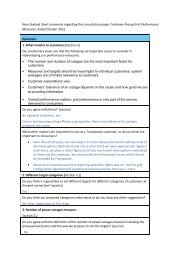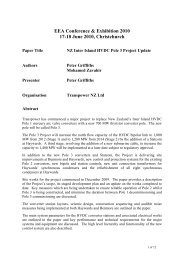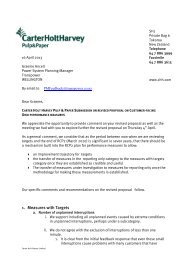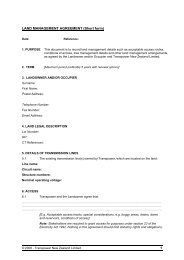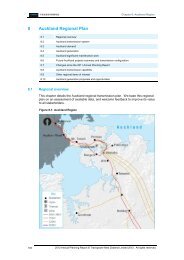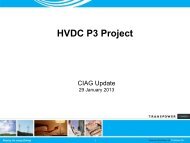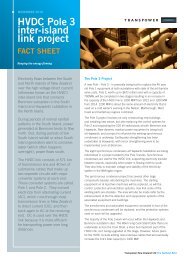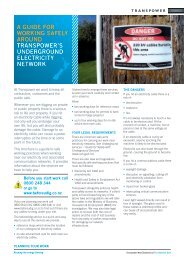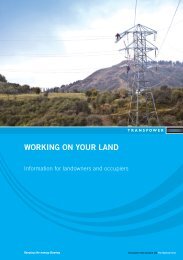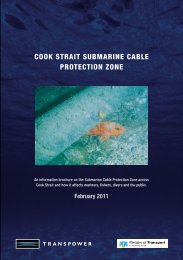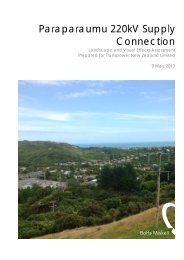- Page 2: ForewordForeword to the Annual Plan
- Page 6 and 7: Executive SummarySummary Figure 1:
- Page 8 and 9: Executive SummaryFeedbackWe will be
- Page 10 and 11: Table of contents2012 Annual Planni
- Page 12: Chapter 1: Introduction1 Introducti
- Page 15: Chapter 1: IntroductionStatusBase C
- Page 20: Chapter 3: Facilitating New Zealand
- Page 23 and 24: Chapter 2: Facilitating New Zealand
- Page 25 and 26: Chapter 3: Existing National GridFi
- Page 27 and 28: Chapter 3: Existing National Grid3.
- Page 29 and 30: Chapter 3: Existing National GridPr
- Page 31 and 32: Chapter 3: Existing National GridFi
- Page 33 and 34: MW00:0001:0002:0003:0004:0005:0006:
- Page 35 and 36: Chapter 4: Demand Assumptionsmethod
- Page 37 and 38: Chapter 5: Generation AssumptionsTa
- Page 39 and 40: Chapter 5: Generation AssumptionsTr
- Page 41 and 42: Chapter 6: Grid Backbone6 Grid back
- Page 43 and 44: Chapter 6: Grid BackboneFigure 6-1:
- Page 45 and 46: Chapter 6: Grid BackboneFigure 6-2:
- Page 47 and 48: Chapter 6: Grid BackboneFigure 6-4:
- Page 49 and 50: Chapter 6: Grid BackboneThe North A
- Page 51 and 52: Chapter 6: Grid BackboneFigure 6-5:
- Page 53 and 54: Chapter 6: Grid BackboneWairakei-Oh
- Page 55 and 56: Chapter 6: Grid BackboneOutagesThe
- Page 57 and 58: Chapter 6: Grid BackboneFor high le
- Page 59 and 60: Chapter 6: Grid BackboneSystem cond
- Page 61 and 62: Chapter 6: Grid BackboneWe will mon
- Page 63 and 64: Chapter 6: Grid Backboneand Welling
- Page 65 and 66: Chapter 6: Grid BackboneFigure 6-10
- Page 67 and 68: Chapter 6: Grid BackboneFigure 6-11
- Page 69 and 70:
Chapter 6: Grid BackboneTable 6-3:
- Page 71 and 72:
Chapter 6: Grid Backbonereinforcing
- Page 73 and 74:
Chapter 6: Grid BackboneThe primary
- Page 75 and 76:
Chapter 6: Grid Backbone6.6.4 Trans
- Page 77 and 78:
Chapter 6: Grid Backbonea thermal u
- Page 79 and 80:
Chapter 6: Grid Backbonenew thyrist
- Page 81 and 82:
Chapter 6: Grid BackboneWith regard
- Page 83 and 84:
Chapter 6: Grid BackboneThe connect
- Page 85 and 86:
Chapter 6: Grid BackboneWe anticipa
- Page 87 and 88:
Chapter 7: Northland RegionThe Nort
- Page 89 and 90:
Chapter 7: Northland RegionNo new t
- Page 91 and 92:
Chapter 7: Northland RegionGrid inj
- Page 93 and 94:
Chapter 7: Northland RegionFigure 7
- Page 95 and 96:
Chapter 7: Northland RegionSolution
- Page 97 and 98:
Chapter 7: Northland Regiona shared
- Page 99 and 100:
Chapter 7: Northland RegionSolution
- Page 101 and 102:
Chapter 7: Northland RegionThe peak
- Page 103 and 104:
Chapter 7: Northland RegionTable 7-
- Page 105 and 106:
Chapter 7: Northland RegionBoth 110
- Page 107 and 108:
Chapter 8: Auckland Region8 Aucklan
- Page 109 and 110:
Chapter 8: Auckland Region8.2.1 Tra
- Page 111 and 112:
Chapter 8: Auckland Regionor demand
- Page 113 and 114:
Chapter 8: Auckland RegionFigure 8-
- Page 115 and 116:
Chapter 8: Auckland RegionTable 8-3
- Page 117 and 118:
Chapter 8: Auckland RegionFigure 8-
- Page 119 and 120:
Chapter 8: Auckland RegionNorth Auc
- Page 121 and 122:
Chapter 8: Auckland RegionIn additi
- Page 123 and 124:
Chapter 8: Auckland RegionSee also
- Page 125 and 126:
Chapter 8: Auckland RegionTable 8-1
- Page 127 and 128:
Chapter 8: Auckland Region8.10.2 Au
- Page 129 and 130:
Chapter 9: Waikato RegionThe Waikat
- Page 131 and 132:
Chapter 9: Waikato Region668 MW by
- Page 133 and 134:
Chapter 9: Waikato RegionTable 9-3:
- Page 135 and 136:
Chapter 9: Waikato Region9.8 Waikat
- Page 137 and 138:
Chapter 9: Waikato Regionfull gener
- Page 139 and 140:
Chapter 9: Waikato RegionTable 9-7:
- Page 141 and 142:
Chapter 9: Waikato Regiona total no
- Page 143 and 144:
Chapter 9: Waikato RegionTable 9-11
- Page 145 and 146:
Chapter 9: Waikato RegionIssueTwo 1
- Page 147 and 148:
Chapter 9: Waikato RegionTable 9-15
- Page 149 and 150:
Chapter 9: Waikato Regionproposing
- Page 151 and 152:
Chapter 10: Bay of Plenty RegionThe
- Page 153 and 154:
Chapter 10: Bay of Plenty Region10.
- Page 155 and 156:
Chapter 10: Bay of Plenty RegionGri
- Page 157 and 158:
Chapter 10: Bay of Plenty RegionFig
- Page 159 and 160:
Chapter 10: Bay of Plenty RegionWe
- Page 161 and 162:
Chapter 10: Bay of Plenty RegionFig
- Page 163 and 164:
Chapter 10: Bay of Plenty Region10.
- Page 165 and 166:
Chapter 10: Bay of Plenty RegionInd
- Page 167 and 168:
Chapter 10: Bay of Plenty RegionOut
- Page 169 and 170:
Chapter 10: Bay of Plenty Regionn-1
- Page 171 and 172:
Chapter 10: Bay of Plenty RegionFol
- Page 173 and 174:
Chapter 11: Central North Island Re
- Page 175 and 176:
Chapter 11: Central North Island Re
- Page 177 and 178:
Chapter 11: Central North Island Re
- Page 179 and 180:
Chapter 11: Central North Island Re
- Page 181 and 182:
Chapter 11: Central North Island Re
- Page 183 and 184:
Chapter 11: Central North Island Re
- Page 185 and 186:
Chapter 11: Central North Island Re
- Page 187 and 188:
Chapter 11: Central North Island Re
- Page 189 and 190:
Chapter 12: Taranaki Region12 Taran
- Page 191 and 192:
Chapter 12: Taranaki RegionWe have
- Page 193 and 194:
Chapter 12: Taranaki Regionand expo
- Page 195 and 196:
Chapter 12: Taranaki RegionFigure 1
- Page 197 and 198:
Chapter 12: Taranaki Regiontiming o
- Page 199 and 200:
Chapter 12: Taranaki RegionPatea (3
- Page 201 and 202:
Chapter 12: Taranaki RegionTable 12
- Page 203 and 204:
Chapter 12: Taranaki Regiondepends
- Page 205 and 206:
Chapter 13: Hawke’s Bay RegionThe
- Page 207 and 208:
Chapter 13: Hawke’s Bay RegionFig
- Page 209 and 210:
Chapter 13: Hawke’s Bay RegionFig
- Page 211 and 212:
Chapter 13: Hawke’s Bay RegionWe
- Page 213 and 214:
Chapter 13: Hawke’s Bay Regiona n
- Page 215 and 216:
Chapter 13: Hawke’s Bay Regioncir
- Page 217 and 218:
Chapter 13: Hawke’s Bay RegionTab
- Page 219 and 220:
Chapter 13: Hawke’s Bay Regionove
- Page 221 and 222:
Chapter 14: Wellington RegionThe We
- Page 223 and 224:
Chapter 14: Wellington Regionused t
- Page 225 and 226:
Chapter 14: Wellington RegionDescri
- Page 227 and 228:
Chapter 14: Wellington Region14.8 W
- Page 229 and 230:
Chapter 14: Wellington RegionThe tw
- Page 231 and 232:
Chapter 14: Wellington Regioncircui
- Page 233 and 234:
Chapter 14: Wellington Region14.8.8
- Page 235 and 236:
Chapter 14: Wellington Regionn-1 ca
- Page 237 and 238:
Chapter 14: Wellington RegionThis i
- Page 239 and 240:
Chapter 15: Nelson-Marlborough Regi
- Page 241 and 242:
Chapter 15: Nelson-Marlborough Regi
- Page 243 and 244:
Chapter 15: Nelson-Marlborough Regi
- Page 245 and 246:
Chapter 15: Nelson-Marlborough Regi
- Page 247 and 248:
Chapter 15: Nelson-Marlborough Regi
- Page 249 and 250:
Chapter 15: Nelson-Marlborough Regi
- Page 251 and 252:
Chapter 16: West Coast RegionThe We
- Page 253 and 254:
Chapter 16: West Coast Regionapprop
- Page 255 and 256:
Chapter 16: West Coast Region16.6 F
- Page 257 and 258:
Chapter 16: West Coast RegionSoluti
- Page 259 and 260:
Chapter 16: West Coast RegionIndica
- Page 261 and 262:
Chapter 16: West Coast Regionstage
- Page 263 and 264:
Chapter 17: Canterbury RegionThe Ca
- Page 265 and 266:
Chapter 17: Canterbury RegionFigure
- Page 267 and 268:
Chapter 17: Canterbury RegionTable
- Page 269 and 270:
Chapter 17: Canterbury RegionTable
- Page 271 and 272:
Chapter 17: Canterbury RegionTable
- Page 273 and 274:
Chapter 17: Canterbury RegionTwo 66
- Page 275 and 276:
Chapter 17: Canterbury RegionIsling
- Page 277 and 278:
Chapter 18: South Canterbury Region
- Page 279 and 280:
Chapter 18: South Canterbury Region
- Page 281 and 282:
Chapter 18: South Canterbury Region
- Page 283 and 284:
Chapter 18: South Canterbury Region
- Page 285 and 286:
Chapter 18: South Canterbury Region
- Page 287 and 288:
Chapter 18: South Canterbury Region
- Page 289 and 290:
Chapter 18: South Canterbury Region
- Page 291 and 292:
Chapter 18: South Canterbury Region
- Page 293 and 294:
Chapter 18: South Canterbury Region
- Page 295 and 296:
Chapter 19: Otago-Southland Region1
- Page 297 and 298:
Chapter 19: Otago-Southland RegionL
- Page 299 and 300:
Chapter 19: Otago-Southland RegionG
- Page 301 and 302:
Chapter 19: Otago-Southland RegionD
- Page 303 and 304:
Chapter 19: Otago-Southland RegionS
- Page 305 and 306:
Chapter 19: Otago-Southland RegionW
- Page 307 and 308:
Chapter 19: Otago-Southland Region1
- Page 309 and 310:
Chapter 19: Otago-Southland RegionW
- Page 311 and 312:
Chapter 19: Otago-Southland RegionI
- Page 313 and 314:
Chapter 19: Otago-Southland RegionT
- Page 315 and 316:
Appendix A: Grid Reliability Report
- Page 317 and 318:
Appendix A: Grid Reliability Report
- Page 319 and 320:
Appendix A: Grid Reliability Report
- Page 321 and 322:
Appendix A: Grid Reliability Report
- Page 323 and 324:
Appendix A: Grid Reliability Report
- Page 325 and 326:
Appendix A: Grid Reliability Report
- Page 327 and 328:
Appendix A: Grid Reliability Report
- Page 329 and 330:
Appendix A: Grid Reliability Report
- Page 331 and 332:
Appendix A: Grid Reliability Report
- Page 333 and 334:
Appendix A: Grid Reliability Report
- Page 335 and 336:
Appendix A: Grid Reliability Report
- Page 337 and 338:
Appendix A: Grid Reliability Report
- Page 339 and 340:
Appendix A: Grid Reliability Report
- Page 341 and 342:
Appendix A: Grid Reliability Report
- Page 343 and 344:
Appendix A: Grid Reliability Report
- Page 345 and 346:
Appendix A: Grid Reliability Report
- Page 347 and 348:
Appendix B: Grid Economic Investmen
- Page 349 and 350:
Appendix C: Fault LevelsAppendix CF
- Page 351:
Appendix C: Fault LevelsGrid exit p
- Page 354 and 355:
Appendix C: Fault LevelsGrid exit p
- Page 356 and 357:
Appendix C: Fault LevelsGrid exit p
- Page 358 and 359:
Appendix C: Fault LevelsGrid exit p
- Page 360 and 361:
Appendix C: Fault LevelsGrid exit p
- Page 362 and 363:
Appendix C: Fault LevelsGrid exit p
- Page 364 and 365:
Appendix D: Project CalendarTable D
- Page 366 and 367:
Appendix D: Project CalendarForecas
- Page 368 and 369:
Appendix D: Project CalendarForecas
- Page 370 and 371:
Appendix D: Project CalendarForecas
- Page 372 and 373:
Appendix D: Project CalendarForecas
- Page 374 and 375:
Appendix E: Investment Approvals Pr
- Page 376 and 377:
Appendix F: Grid Support ContractsF
- Page 378 and 379:
Appendix F: Grid Support ContractsF
- Page 380 and 381:
Appendix G Generation ScenariosAppe
- Page 382 and 383:
Appendix G Generation ScenariosYear
- Page 384 and 385:
MWAppendix G Generation Scenarios14
- Page 386 and 387:
MWAppendix G Generation ScenariosYe
- Page 388 and 389:
MWAppendix G Generation ScenariosG.
- Page 390 and 391:
MWAppendix G Generation ScenariosIn
- Page 392 and 393:
MWMWMWAppendix G Generation Scenari
- Page 394 and 395:
Appendix H: Project NamingAppendix
- Page 396 and 397:
Appendix I: GlossaryAppendix IGloss
- Page 398 and 399:
Appendix I: GlossaryTermgeneratorgr
- Page 400 and 401:
Appendix I: GlossaryTermsteady stat
- Page 402 and 403:
Appendix J: Grid Exit and Injection




